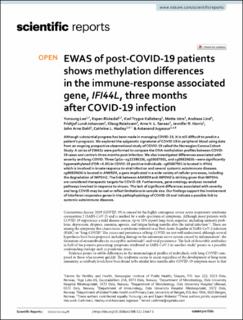| dc.contributor.author | Lee, Yunsung | |
| dc.contributor.author | Riskedal, Espen | |
| dc.contributor.author | Kalleberg, Karl Trygve | |
| dc.contributor.author | Istre, Mette Stausland | |
| dc.contributor.author | Lind, Andreas | |
| dc.contributor.author | Lund-Johansen, Fridtjof | |
| dc.contributor.author | Reiakvam, Olaug Marie | |
| dc.contributor.author | Søraas, Arne Vasli | |
| dc.contributor.author | Harris, Jennifer Ruth | |
| dc.contributor.author | Dahl, John Arne | |
| dc.contributor.author | Lund Hadley, Cathrine | |
| dc.contributor.author | Jugessur, Astanand | |
| dc.date.accessioned | 2022-09-28T12:38:25Z | |
| dc.date.available | 2022-09-28T12:38:25Z | |
| dc.date.created | 2022-09-27T08:25:34Z | |
| dc.date.issued | 2022 | |
| dc.identifier.issn | 2045-2322 | |
| dc.identifier.uri | https://hdl.handle.net/11250/3022282 | |
| dc.description.abstract | Although substantial progress has been made in managing COVID-19, it is still difficult to predict a patient’s prognosis. We explored the epigenetic signatures of COVID-19 in peripheral blood using data from an ongoing prospective observational study of COVID-19 called the Norwegian Corona Cohort Study. A series of EWASs were performed to compare the DNA methylation profiles between COVID-19 cases and controls three months post-infection. We also investigated differences associated with severity and long-COVID. Three CpGs—cg22399236, cg03607951, and cg09829636—were significantly hypomethylated (FDR < 0.05) in COVID-19 positive individuals. cg03607951 is located in IFI44L which is involved in innate response to viral infection and several systemic autoimmune diseases. cg09829636 is located in ANKRD9, a gene implicated in a wide variety of cellular processes, including the degradation of IMPDH2. The link between ANKRD9 and IMPDH2 is striking given that IMPDHs are considered therapeutic targets for COVID-19. Furthermore, gene ontology analyses revealed pathways involved in response to viruses. The lack of significant differences associated with severity and long-COVID may be real or reflect limitations in sample size. Our findings support the involvement of interferon responsive genes in the pathophysiology of COVID-19 and indicate a possible link to systemic autoimmune diseases. | en_US |
| dc.language.iso | eng | en_US |
| dc.publisher | Nature | en_US |
| dc.rights | Navngivelse 4.0 Internasjonal | * |
| dc.rights.uri | http://creativecommons.org/licenses/by/4.0/deed.no | * |
| dc.title | EWAS of post-COVID-19 patients shows methylation differences in the immune-response associated gene, IFI44L, three months after COVID-19 infection | en_US |
| dc.type | Journal article | en_US |
| dc.type | Peer reviewed | en_US |
| dc.description.version | publishedVersion | en_US |
| dc.rights.holder | Copyright 2022 The Author(s) | en_US |
| dc.source.articlenumber | 11478 | en_US |
| cristin.ispublished | true | |
| cristin.fulltext | original | |
| cristin.qualitycode | 1 | |
| dc.identifier.doi | 10.1038/s41598-022-15467-1 | |
| dc.identifier.cristin | 2055703 | |
| dc.source.journal | Scientific Reports | en_US |
| dc.identifier.citation | Scientific Reports. 2022, 12, 11478. | en_US |
| dc.source.volume | 12 | en_US |

